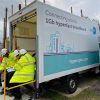Suffolk Council UK Awards GBP40m Superfast Broadband Contract to BT
The Suffolk County Council (SCC) has today confirmed that its £40 million contract to make superfast broadband (25Mbps+) services available to 85-90% of local homes and businesses by 2015 has unsurprisingly been awarded to BT. Just 2% of the “hardest to reach premises” will be left with sub-5Mbps speeds.
Precise details will not be known until the Local Broadband Plan (LBP) contract between BT and the council is finalised by mid-October 2012 and formally awarded by the end of that same month. The entire project, which has also “guaranteed broadband speeds of at least 2 megabits per second” to everybody, is expected to be completed by June 2015.
Advertisement
Councillor Mark Bee, Chair of the Better Broadband for Suffolk Project, said:
“When we launched the Better Broadband for Suffolk campaign, we wanted to ensure that everyone who lives and works in our county benefits. Today I’m proud to say that we will deliver.
Improving access to broadband is going to help Suffolk’s economy grow by as much as and create up to 5000 new jobs. There’s a digital divide between Suffolk and the rest of the country but an even more acute disparity between urban and rural Suffolk. The Better Broadband programme is going to close those gaps, boost school attainment and help the public sector to deliver services more efficiently and cheaply.
Since I became leader of the county council, I have been determined to get Suffolk’s broadband aspirations back on track. I’m therefore delighted that we’ve come such a long way in such a short space of time. By the end of the year, the first properties are going to start benefiting from the programme and within three years, broadband access across Suffolk is going to be unrecognisable from what it is today.”
Few will be surprised by today’s announcement after BT’s only rival in the Broadband Delivery UK (BDUK) process, Fujitsu, confirmed earlier this month that it had pulled out from bidding (here). On top of that the UK government recently labelled future IT and telecoms contracts from Fujitsu as “high risk” (here).
Interestingly SCC anticipates that the first premises to be connected through the Better Broadband For Suffolk programme will do so by the end of 2012, which implies a strong degree of confidence that Europe’s on-going competition concerns will indeed be resolved by the end of this month (here).
Mark is a professional technology writer, IT consultant and computer engineer from Dorset (England), he also founded ISPreview in 1999 and enjoys analysing the latest telecoms and broadband developments. Find me on X (Twitter), Mastodon, Facebook, BlueSky, Threads.net and Linkedin.
« UK ISPs Criticise “Flawed” Broadband ISP Tax Idea to Save Newspapers


















































Comments are closed